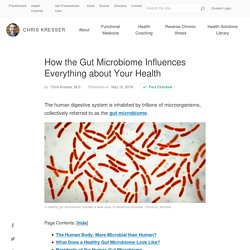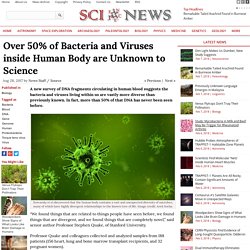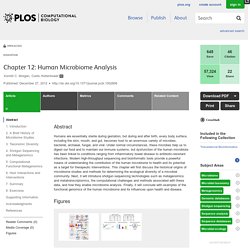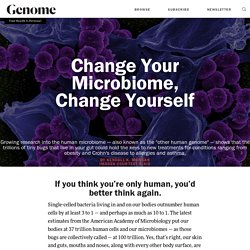

The Gut Microbiota News Watch 2016 Top 10 - Gut Microbiota for Health. How the Gut Microbiome Influences Your Overall Health. Your gut microbiome regulates many physiological functions, both locally in your gut and systemically in diverse tissues and organs ranging from your heart to your skin.

Read on to learn about the numerous ways in which gut microbes impact our health, the consequences of gut microbiome disruption, and simple diet and lifestyle changes that optimize the health of your gut microbiome. You Are What You Eat, And What You Eat Is Millions of Microbes. Poop is nothing short of a scientific miracle.

It helps researchers understand the diets of dinosaurs, trace the spread of ancient disease and recognize parasitic infection. Excitement over the microbiome needs to be kept in check. — The American Microbiome Institute. 10 Common Misconceptions About the Human Microbiome. Over 50% of Bacteria and Viruses inside Human Body are Unknown to Science. A new survey of DNA fragments circulating in human blood suggests the bacteria and viruses living within us are vastly more diverse than previously known.

In fact, more than 50% of that DNA has never been seen before. Kowarsky et al discovered that the human body contains a vast and unexpected diversity of microbes, many of which have highly divergent relationships to the known tree of life. Image credit: Arek Socha. Harnessing the amazing work of the 40 trillion chemists in your gut microbiome. Deep in your gut, 40 trillion chemists are hard at work helping you digest your lunch, making essential vitamins and nutrients you can’t produce on your own, protecting you from disease, and more.

These talented creatures are bacteria, fungi, and other single-celled organisms. These organisms live together in complex communities called microbiomes. They reside all over your body — and far beyond it. Microbiomes have been found anywhere scientists choose to look for them, from the hottest deserts to lakes hidden deep beneath Antarctic ice. Me, myself, us. WHAT’S a man?

Or, indeed, a woman? Biologically, the answer might seem obvious. A human being is an individual who has grown from a fertilised egg which contained genes from both father and mother. A growing band of biologists, however, think this definition incomplete. The Microbiome. Everyone’s got a personal collection of microbiota.

Chapter 12: Human Microbiome Analysis. Abstract Humans are essentially sterile during gestation, but during and after birth, every body surface, including the skin, mouth, and gut, becomes host to an enormous variety of microbes, bacterial, archaeal, fungal, and viral.

Under normal circumstances, these microbes help us to digest our food and to maintain our immune systems, but dysfunction of the human microbiota has been linked to conditions ranging from inflammatory bowel disease to antibiotic-resistant infections. Modern high-throughput sequencing and bioinformatic tools provide a powerful means of understanding the contribution of the human microbiome to health and its potential as a target for therapeutic interventions. This chapter will first discuss the historical origins of microbiome studies and methods for determining the ecological diversity of a microbial community. How to Use Your Second Brain: Microbiome Expert Laure Ysebrant on Strategic Eating, Building Immunity, and Fake Fibre. Change Your Microbiome, Change Yourself. If you think you’re only human, you’d better think again.

Single-celled bacteria living in and on our bodies outnumber human cells by at least 3 to 1 — and perhaps as much as 10 to 1. The latest estimates from the American Academy of Microbiology put our bodies at 37 trillion human cells and our microbiomes — as those bugs are collectively called — at 100 trillion. Yes, that’s right, our skin and guts, mouths and noses, along with every other body surface, are home to 100,000,000,000,000 microscopic bugs. The Beautiful Intelligence of Bacteria and Other Microbes. Another type of behavior demonstrated by biofilms growing under laboratory conditions is spiral migration, demonstrated in the time-lapse video below of Bacillus mycoides.

These bacterial cells grow in long chains or filaments that curl either clockwise or counterclockwise. The specific advantages of this spiraling movement are still under investigation, according to Chimileski, but they must be considerable because B. mycoides excels at taking over available environments. “Bacillus mycoides is one of the easiest bacterial species to cultivate from the soil,” he explained.
When scientists isolate microbes from soil and grow them on agar dishes, particularly at room temperature, “the mycoides will often spread across the entire plate and overtake all of the other organisms. Microbiome: 5 Surprising Facts About the Microbes Within Us. As far back as we know, animals have been home to microbes.

Scientists have known for some time that these tiny tenants have the ability to make humans powerfully sick, while others are vital to maintaining the body's normal flora and fauna. Collectively, the microbes inside everyone make up the "microbiome" — what microbiologist Martin Blaser of the NYU School of Medicine defines as "all the organisms that call us home, that live in us and that interact with each other and with ourselves.
" These teensy creatures, from bacteria and fungi to protozoans (mostly single-celled animal-like organisms), have a surprisingly rich story to tell. Here are five fascinating facts about the critters that call your body home. Error loading player: No playable sources found Your body has more microbes than human cells The human body is teeming with microbes. You are born bacteria-free With all these bacteria living inside, it seems natural that humans would just be born with them. The microbiome has been called the forgotten organ — and it could hold the ‘next paradigm shift in science and medicine’ The bugs that live in our gut might one day soon be used to guide the way we treat everything from infections to cancer. Scientists have been working on ways to use the microbiome, or the assortment of microorganisms that live in and on us, to unlock new treatments for difficult diseases.
It’s led to new companies — both on the medical side and in agriculture — that are taking a range of approaches to looking at the microbiome. Your Microbiome Controls Your Life. Gut reaction: the surprising power of microbes. ‘So, what’s in the thermos?” I asked. I was standing in a lift at Washington University in St Louis, with Professor Jeff Gordon and two of his students, one of whom was holding a metal canister. “Just some faecal pellets in tubes,” she said. “They’re microbes from healthy children, and also from some who are malnourished. We transplanted them into mice,” explained Gordon, as if this was the most normal thing in the world. A Lifestyle Prescription for Optimal Health: Microbiota – the Indispensable “Organ” – 4. A Lifestyle Prescription for Optimal Health: Microbiota – the Indispensable “Organ” – 4 We are not alone, neither in our social settings nor as individuals.
The fact is that we are involved in symbiotic relationships for our self-preservation that we are only just beginning to understand and appear to be more powerful than we currently have the ability to appreciate. There is no such thing as a ‘good’ or a ‘bad’ microbe. In the 1870s, German physician Robert Koch was trying to curtail an epidemic of anthrax that was sweeping local farm animals. Other scientists had seen a bacterium, Bacillus anthracis, in the victims’ tissues. Koch injected this microbe into a mouse – which died. He recovered it from the dead rodent and injected it into another one – which also died. Doggedly, he repeated this grim process for over 20 generations and the same thing happened every time. Scientists bust myth that our bodies have more bacteria than human cells. Red blood cells dominate our total cell count by number (though not by mass). It's often said that the bacteria and other microbes in our body outnumber our own cells by about ten to one.
That's a myth that should be forgotten, say researchers in Israel and Canada. The ratio between resident microbes and human cells is more likely to be one-to-one, they calculate. A 'reference man' (one who is 70 kilograms, 20–30 years old and 1.7 metres tall) contains on average about 30 trillion human cells and 39 trillion bacteria, say Ron Milo and Ron Sender at the Weizmann Institute of Science in Rehovot, Israel, and Shai Fuchs at the Hospital for Sick Children in Toronto, Canada. Those numbers are approximate — another person might have half as many or twice as many bacteria, for example — but far from the 10:1 ratio commonly assumed. Source: Ref. 1. Fast Facts about the Microbiome. The Environment Within: Exploring the Role of the Gut Microbiome. The Human Microbiome - Interactive Website. There Is No ‘Healthy’ Microbiome. But Mr. How 'Bad' Gut Bacteria Can Change Their Evil Ways. The More Diverse Your Gut Flora.
This is a post from the Gut Critters blog that ended November 18, 2016. Ray Medina gave permission for his material to be copied as long as it was attributed to him and not used for commercial purposes. – kiraonysko
New Catalog of Human Gut Microbes. An updated analysis of the gut microbiome extends the list of known bacterial genes to 9.8 million. WIKIMEDIA, MATTOSAURUSAn expanded catalog of nearly 9.8 million genes from the human gut microbiome spans a cohort of bacteria three times larger than that used to create previous gene lists. The results, published this week (July 6) in Nature Biotechnology, integrate data from newly sequenced samples and previous studies to provide near-complete gene sets for most gut microbes. The Microbe Directory: An annotated, searchable inventory of microbes’ characteristics - Gates Open Research. Introduction. Microbial Menagerie. It’s in the Genes. Immune cells surrounding hair follicles in mouse skin. These hair follicles are home to a diverse array of commensal bacteria.FLICKR, NIAIDScouring the genomes and body-wide microbial communities of 93 people, researchers have discovered a link between the composition of the microbiome and genetic variation in innate immunity, phagocyte function, and other immune pathways.
The research was presented by University of Minnesota population geneticist Ran Blekhman today (October 24) at the American Society of Human Genetics 2013 annual meeting in Boston. Divided by language, united by gut bacteria – people have three common gut types - Not Exactly Rocket Science. Europe is a divided land. For such a relatively small continent, it is split into 50 different countries and its people speak hundreds of languages. Gut Microbes for Life. What's in Your Poo? - Scientific American Blog Network. My guess is, you rarely stop to consider the contents of your feces. Cohabiting family members share microbiota with one another and with their dogs.